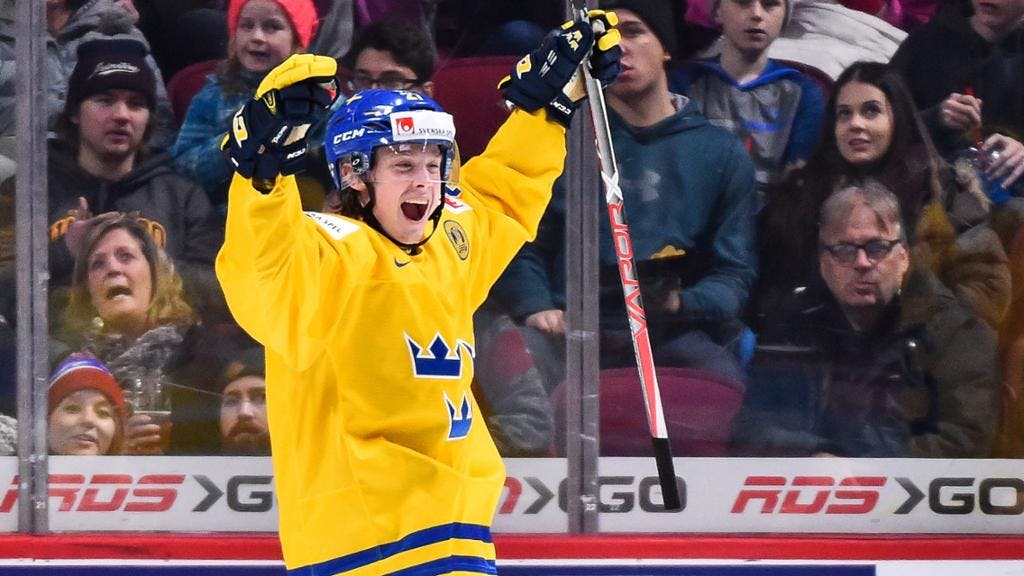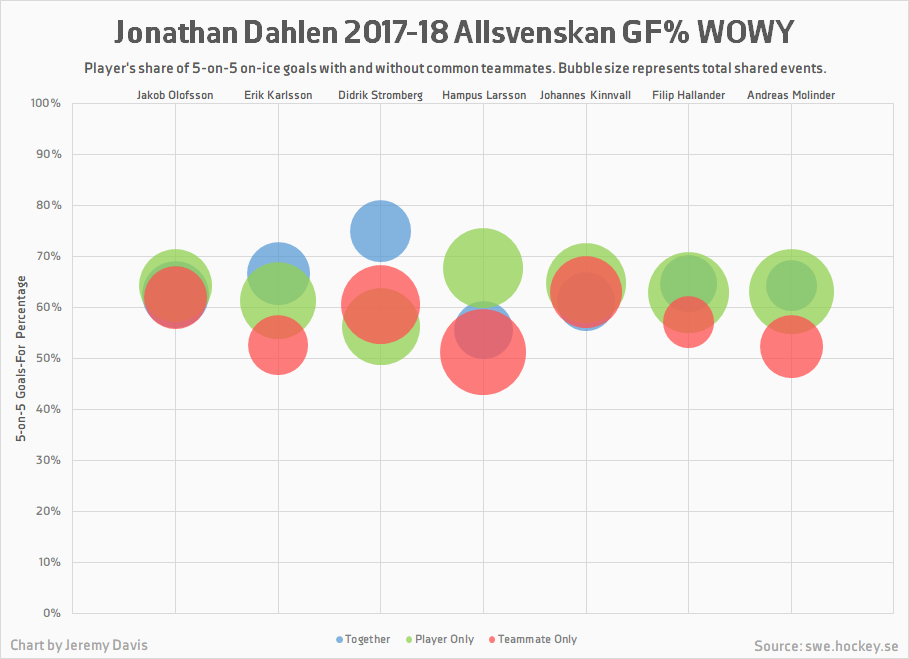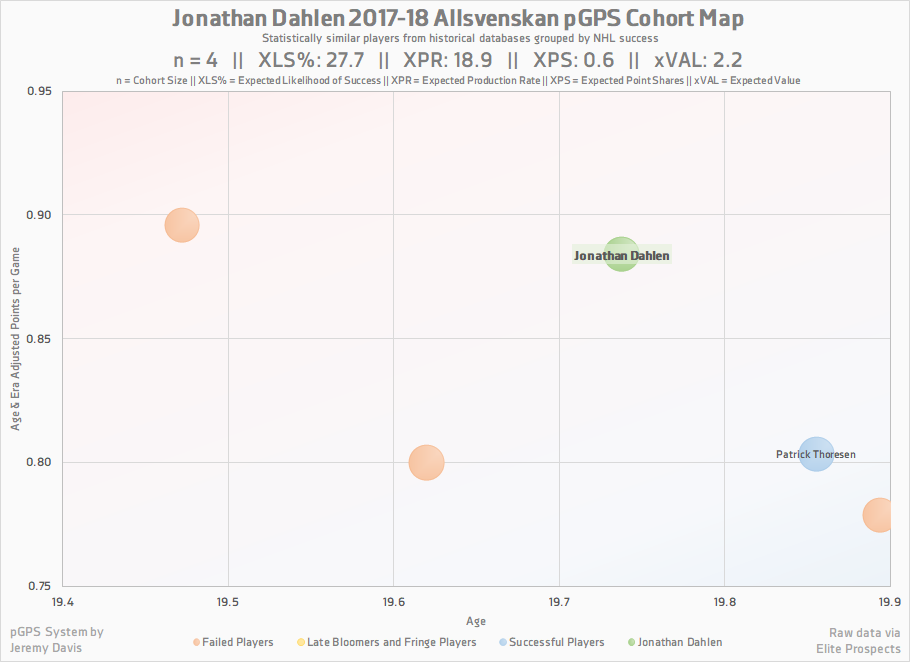CanucksArmy’s 2018 “Midterm” Prospect Rankings: #5 Jonathan Dahlen

By Harman Dayal
5 years agoGetting a read on Jonathan Dahlen’s draft-plus two season is difficult when considering the extraneous factors at play.
The original plan for Dahlen this year was to come to training camp and eventually play in the AHL to become acquainted with the North American ice and style of game. Unfortunately, that idea fell off the tracks when Dahlen suffered mononucleosis– a sickness that took the Swedish winger out of the Young Stars’ tournament and training camp.
Mono is renowned for lingering effects including fatigue that can affect the victim for up to several months. The Canucks didn’t want to leave Dahlen in a vulnerable position in the AHL, so they loaned him back to Timra IK of the Allsvenskan with a January 31st opt-out clause that could prompt a transfer to the SHL. That clause came and passed with Dahlen choosing to remain with Timra so as to aid his club of three years in their promotion attempts.
Dahlen’s performance as both the Allsvenskan Top Forward and MVP is enough for him to check in as the 5th best Canucks’ prospect.
Numbers

For all that’s made about Dahlen’s success with Timra, it’s fair to point out that he was unable to improve on his 2016/17 point totals. The contextual factors around him definitely changed with Elias Pettersson gone, though Dahlen did have two highly ranked 2018 draft-eligible prospects step up in Pettersson’s stead. Jacob Olofsson and Filip Hallander are both fringe first-round prospects that saw chunks of ice-time centring Dahlen.
What’s interesting is that neither Olofsson or Hallander seemed to reap the rewards of playing with Dahlen on their wings. Both centres actually produced more points per hour away from him than they did with him. In fact, Dahlen’s overall impact on his teammates’ scoring rate was mixed– not what you’d expect of an MVP calibre player.

Where Dahlen did have a positive effect on his teammates was with their ability to control on-ice goals scored.

Dahlen’s relatively neutral effect on his teammates’ scoring rates means that he’s unlikely to be an even-strength offensive catalyst at the NHL level. That may sound pessimistic, but it’s not an indictment on his abilities or potential. Rather, it’s to highlight that Dahlen should be seen as a complementary piece for a scoring line as he climbs through the ranks. It’s an assertion that makes sense when considering his plaudits as a clinical finisher as opposed to a dynamic creator.
pGPS
Dahlen’s statistical stagnation is reflected through the lens of the prospect Graduation Probabilities System. This was Dahlen’s third season in the tier-two Swedish league and while he continued dominating, he was unable to show statistical progression year over year.

Dahlen’s unique career path leaves him with few historical comparables when considering his scoring and stature based profile. The 20-year-old’s expected likelihood of success stands at just 27.7%, with an underwhelming expected production rate of 18.9 points.
pGPS definitely undersells Dahlen’s probability of success at the NHL level. Had it not been for his mono contraction, it’s likely that Dahlen spends most of the past season in a superior league like the SHL or AHL. Playing in a more competitive league would have definitely boosted his pGPS profile.
Scouting Report
My assessment of Dahlen as a complementary offensive piece moving forward makes a lot more sense when you watch him play.
Dahlen may be undersized at just 5’11 and 175 pounds, but he does most of his damage in tight, below the hash marks. He’s a smart and elusive player around the net in that he finds seams and routes to slip between defenders and get open right in front of the blue paint. By the time opposing defenders detect the coverage lapse, he’s likely already scored a tap-in. In the instances where the opposing team is well positioned, he likes to peel off to the side where can take advantage of his lightning-quick hands. Those hands aid in his stickhandling, which proves to be a huge asset when it comes weaving in and out of traffic while driving to the net, protecting the puck while waiting for a play to develop, or executing an extra move to create an angle for a high-percentage shot attempt.
Skill around the net isn’t the only tool in Dahlen’s offensive kit. His underrated vision allows him to commonly find teammates for cross-ice passes after drawing defenders himself. On the rush, Dahlen excels as a traditional up-and-down winger that can both get in on the forecheck or skate up the wall to snap off a wrister.
The common criticism for Dahlen is the explosiveness in his first few strides. Having said that, his overall skating ability is fine and shouldn’t be seen as a detriment to his bread and butter game down low. If anything, it could affect his transition game on the rush, though he doesn’t rely on it much for offensive success anyway.
There’s a lot to like with Dahlen’s offensive package, but it’s fair to wonder how that might translate onto the smaller North American ice rinks. Fortunately, we had the chance to answer that exact question when Dahlen joined the Utica Comets for six games down the stretch. Few in the industry followed him closer in Utica than resident Comets’ expert Cory Hergott, and so it was a no-brainer to turn to him for his assessment of Dahlen’s game in the AHL.
[Dahlen] showed excellent edge work with his skating, he wasn’t afraid to go to the dirty areas of the ice, in fact, he seemed to be seeking those areas out. He put up one goal and two helpers during those six games, but he also showed well on the defensive side of the puck, often being the first forward into his own zone on the back check. He showed a knack for drawing defenders to him and being able to dish a filthy pass to a teammate for a scoring chance.I have seen a lot of people penciling Dahlen onto the Canucks roster for next season already. I am not sure that he will be ready to make the team out of camp, as I feel like he will need a little more time in Utica to sort out the North American game.
The move to flip an ageing Alex Burrows for Jonathan Dahlen at the 2017 trade deadline might just go down as Jim Benning’s best trade to date. Dahlen’s skating ability could limit his abilities as a dynamic offensive threat, but his hockey sense in the offensive zone enables him to read off of and flourish with playmakers that think a step ahead. Afford him some patience as he adapts his game against tougher defensemen, and there’s no reason to think that he can’t be a contributor for a scoring line down the road.
Recent articles from Harman Dayal





